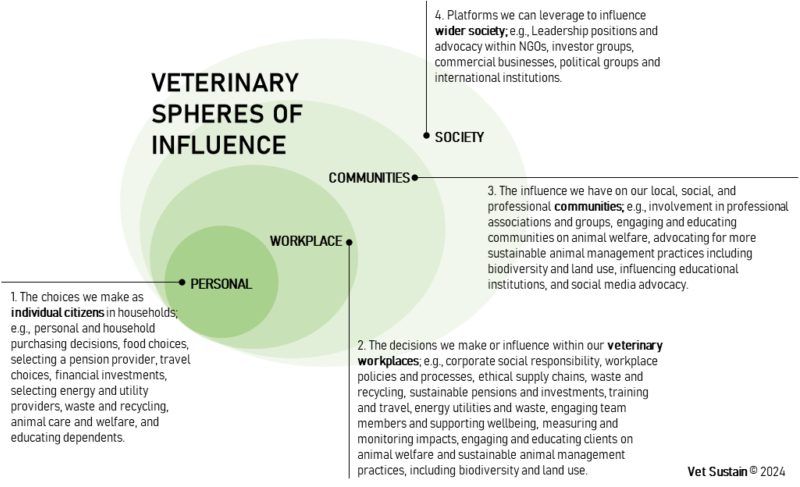Using our veterinary ‘Spheres of Influence’ to enhance biodiversity
How can veterinary professionals utilise their unique skills, knowledge, relationships, and influence to help protect wildlife and biodiversity? In this blog, Vet Sustain Director Laura Higham introduces the veterinary ‘Spheres of Influence’, and describes how this simple idea can be used to inspire personal action plans for nature.
Laura Higham, Vet Sustain
Veterinary work is all consuming – for many of us, a vocation and a life choice borne out of a love of animals, academic achievement and ambition, and dogged determination and resolve. The highs and rewards of veterinary practice sometimes come at a personal cost, and it can feel like we’re pouring from an empty cup.
So when someone asks you to do more, or suggests a change from a very established approach, it can feel like a personal criticism, devoid of understanding of just how hard it is to do the basics well.
Often, that’s exactly how ‘sustainability’ is presented – a list of urgent asks to save the planet, because positive action and impact are exactly what we need right now. But for veterinary professionals, where is the space to do more or to change, when our cups are running empty?
Veterinary superpowers
Instead of expecting action from listed demands, we need deep, sustained action that taps into what we as individuals care passionately about, and where our personal opportunities lie.
To understand these opportunities, Vet Sustain often reflects on veterinary professionals’ unacknowledged superpowers: superpowers in the skills and knowledge spanning multiple disciplines; superpowers in relating to people through animals; and superpowers in our multiple ‘spheres of influence’, from individual to societal levels (see Figure 1).
Acknowledging these spheres, sustainability can shift from being yet another time burden to feel guilty about, to becoming an opportunity to gain confidence and wellbeing from practical actions that leverage our skills to affect change. These spheres can be used to create personal action plans for specific elements of sustainability.

Figure 1: The veterinary spheres of influence. © Vet Sustain
The 6Ws
Vet Sustain has recently published our ‘6Ws’ of veterinary sustainability – six areas in which veterinary professionals have a unique opportunity to support the United Nations Sustainable Development Goals. One of these goals is Wildlife, which we can all support through our many different roles in clinical practice, policy, research, teaching and academia, government, non-governmental organisations, or industry.
Biodiversity action
For each sphere of influence, we can conduct a mini audit of how our choices could better support nature. For example:
At personal level, we can consider how our personal and household purchasing decisions, food choices, pension providers and investments, modes of travel, energy and utility providers, waste and recycling, the education of children and other dependents, and the care of our own animals, could be shaped to support wildlife.
You might like to check out Vet Sustain Director Jen Gale's Sustainable(ish) website, books, and social media for inspiration on sustainable living.
At workplace level,we might think about corporate social responsibility and workplace policies and practices – and our roles in establishing these as leaders, or supporting their uptake and implementation as employees. We could consider our organisation’s pension provider and investments, training and travel, energy and recycling providers, team wellbeing, engaging clients on nature-friendly animal care and management, and monitoring and evaluating our workplace’s performance on supporting wildlife.
For example, the RSPCA and partners (including Vet Sustain) have launched a Wildlife Toolkit, which could be adopted and implemented as part of a veterinary practice policy, alongside wildlife-friendly outdoor areas for nature and staff wellbeing.
At community level, there might be opportunities to inspire a larger number of people through professional associations and member bodies, engaging local communities on action for nature, influencing educational institutions and using social media.
As an example, vet and children's author Gill Lewis is campaigning for nature protections in her local community, whilst writing nature books for children to inspire the next generation.
Finally, as veterinary professionals, we can inspire change at societal level. Not all of us will become Members of Parliament or members of the House of Lords (although some will!); however, many roles are open to veterinary professionals within charitable organisations, investor groups, commercial businesses, political groups and international institutions, with considerable scope for influencing policy change for a nature-friendly society.
For example, Vet Sustain Ambassador and record-breaking ultra-marathon runner Jasmin Paris uses her international platform to promote The Green Runners and their four pillars for the environment, asking "‘How you move, How you fuel, How you kit up, and How you speak out?".
In summary, impactful changes can be planned and enacted to support nature within the multiple veterinary ‘spheres of influence’. As individual citizens, members of a veterinary workplace, members of communities, and in wider society, veterinary professionals have a unique skill set, relationships and influence to act as a powerful force for nature – with benefits for our own confidence and wellbeing, too.